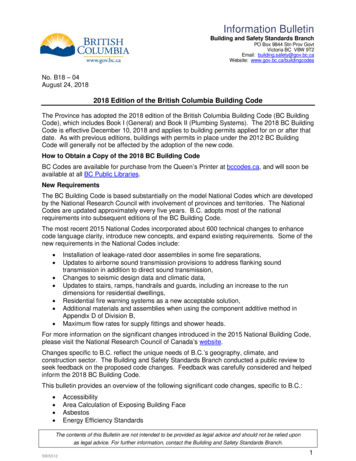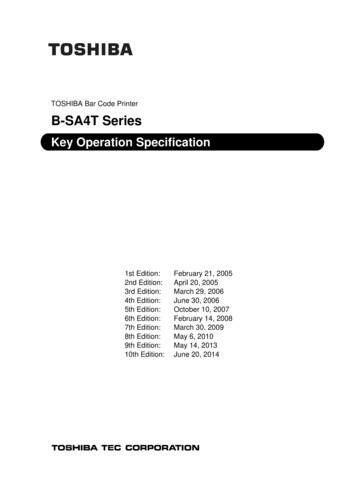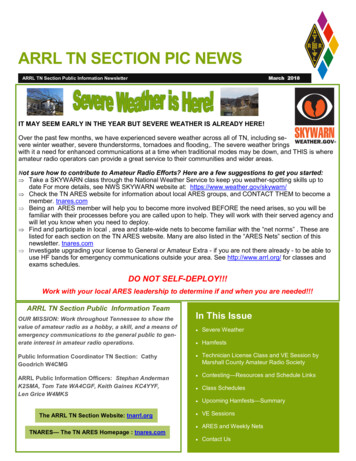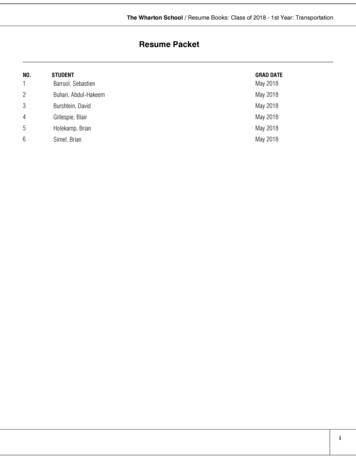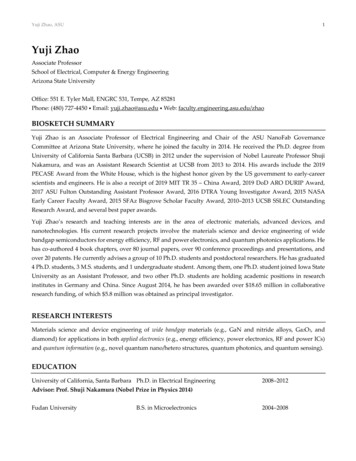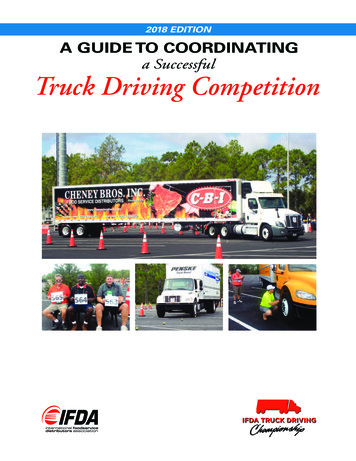
Transcription
2018 EDITIONA GUIDE TO COORDINATINGa SuccessfulTruck Driving CompetitionIFDA TRUCK DRIVING
Each year, the International Foodservice DistributorsAssociation (IFDA) holds the IFDA Truck DrivingChampionship. Held for more than 30 years, this isthe only “national level” truck driving competition for a specific industry and each year it attracts the best food industrydrivers from across North America.To participate in the event, a driver must be the winner of acompany sponsored competition (at a divisional or higherlevel) or be the highest placing company driver at a state,local, regional, or provincial truck driving competition.(Note: If the highest placing driver is not the first place winner, aminimum number of five drivers from that division/companymust have competed in that class.)This guidebook is provided for companies interested in holding a division or company competition.Why Your Company Should Participate in aTruck Driving CompetitionA truck driving competition can be an important tool in yourtotal safety program, promoting driver skills and knowledgeand lowering the costs associated with deficient or unsafepractices. This event also provides a powerful incentive forsuperior performance, establishes a sense of company pride,and offers tangible evidence to your community, your drivers,and your drivers’ families that your company has a genuineconcern for safety and professional driving conduct in the operation of your fleet.The competition described in this guide is similar to theIFDA Truck Driving Championship and contains three parts:Written Exam - To measure a driver’s knowledge of safetyand operating procedures.Vehicle Inspection - To “uncover” planted equipment defects and safety hazards and to determine readiness of the vehicle for operation.General Information for Conductinga Truck Driving CompetitionDriver EligibilityIt is important that all contestants meet minimum requirements for competition. Requirements for the IFDA TruckDriving Championship are:1. Contestants must have at least one year of continuous employment with your company as a full-time driver (not a supervisor). Participating companies must be involved in fooddistribution and must have their own private fleets.2. The driver must have a clean driving record, free of the following infractions for the twelve months prior to the competition: Chargeable Accidents Alcohol Related Charges Drug Related Charges3. The driver must be the winner of a company sponsoredcompetition or the highest placing company representative ata state, local, regional, or provincial truck driving competition.4. The driver must have the proper Commercial Drivers License for the type of vehicle used in the competition in whichhe/she will compete. The three classes of competition include: Straight Truck (typically 2-axle) 3-Axle (typically 28-foot trailers) 5-Axle (typically 48-foot trailers or 53-foot trailers)All drivers entered in the IFDA Truck Driving Championshipare required to submit certain driver information for the yearprior to the competition. To ensure that the driver meets theeligibility requirements, the CEO, Division President, or VicePresident of Distribution/Operations must sign a verificationletter for each driver.Driving Course Problems - A series of problems simulat-ing everyday operating conditions.Help in Coordinating Your Truck DrivingCompetitionIf, after reading this guidebook, you have a question relatingspecifically to the IFDA Truck Driving Championship, pleasecontact IFDA at (703) 532-9400.Personnel Requirements for Holding aCompetitionPersonnel requirements will vary depending on the drivingcourse selected and the number of judges available. The following allocations are based on previous IFDA Truck DrivingChampionship requirements:1. Lead Judge – 1 person. This individual conducts the orientation, prepares the judges, designs the driving course, identifies the planted vehicle defects, conducts the driverPAGE 1
walkthrough, makes sure things are “on schedule” and is the“go-to” person for any questions or issues that arise.The number of classes of competition in your event woulddepend on your operation.2. Written Examination – 2 to 3 people to review andWhen conducting your competition, it is important that allvehicles in the same class of competition are identicallyspec’d. For example, if single axle tractors are used on thedriving course, each tractor should have the same wheelbase,fifth wheel setting, cab style, etc. This is done to ensure thateach driver is tested under conditions identical to those facedby other competitors. No driver should be perceived as having an advantage over another. For this reason, driversSHOULD NOT use his/her normally assigned tractor whengoing through the driving course.score the exams. Normally, the written exam takes place priorto the driving course and the pre-trip inspection, so the individuals who score the exams can also help out elsewhere later.3. Pre-Trip Vehicle Inspection – 1 person per vehicle. De-pending on the number of drivers competing, the pre-trip inspection can take place at the same time as the driving course.This can help reduce the overall time of the event.4. Driving Course Judges – 6-12 people. A typical drivingcourse consists of 6 problems; 1 to 2 judges per problem.5. Equipment Handlers – 2 people. These individuals posi-tion the equipment at the start line, and drive the equipmentfrom the stop line to the start line.6. Starter – 1 person. This individual makes sure the drivers’mirrors are positioned properly before signaling the driver tostart and activates the stop watch as the vehicles’ frontbumper crosses the start line.7. Timekeepers – 2 people. These individuals follow the ve-hicle as it goes through the driving course, pick up the scoresheets from the driving course judges, and bring the scoresheets to the scorekeepers for tabulation.The Lead Judge and the Handlers should be members of yourtransportation management team. Other judges can be distribution center personnel, department heads, sales personnel,mechanics, members of local law enforcement agencies, stateregulatory offices, and local transportation and safety clubs.Communicate requirements to all officials/judges in advanceof the event. Depending on the level of secrecy regarding thedriving course, you may elect to not make problem-specificinformation available until the orientation. This is the timefor all questions to be asked and answered regarding properscoring and judging procedures.Classes of CompetitionThe types of vehicles most commonly used in food distribution determine the number of vehicle classes and the actualvehicles used at the IFDA Truck Driving Championship.Only conventional power units are used (no cabovers) in theIFDA Truck Driving Championship, and there are three (3)classes of competition, as noted earlier:Structure of the CompetitionAs mentioned previously, the IFDA Truck Driving Championship includes three parts: Written Examination Pre-Trip Inspection Driving Course ProblemsBelow are key details on the written exam and pre-trip inspection, followed by in-depth instruction of the drivingcourse portion of a successful competition.Written ExaminationThe written exam is used to measure the driver’s knowledgeof job responsibilities and safety practices as set forth in themost recent versions of the Federal Motor Carrier Safety Regulations Handbook (available at www.jjkeller.com) and theFacts for Drivers handbook (available from the AmericanTrucking Association at www.atabusinesssolutions.com). Youmay also want to include questions on rules and proceduresspecific to your operating territory.The written examination at the IFDA Truck Driving Championship consists of 40 questions (a mixture of true/false andmultiple choice) and must be completed within one hour.Physical arrangements for the written exam should includetables, chairs, pencils, and erasers. An official should explainthe rules and periodically announce the time remaining tocomplete the examination. Straight Truck 3-Axle 5-AxlePAGE 2
Sample Written Examination Questions1. Which of these statements about downshifting is true?a. When you downshift for a curve, you should do so before you enter the curve.b. When you downshift for a hill, you should do so afteryou start down the hill.c. When you downshift for a curve, you should do so afteryou enter the curve.2. Which is the best way to use the brake pedal on a steepdownhill grade?a. Light, pumping action.b. Light, steady pressure.c. Repeated strong pressure, then release.3. Which of these statements about handling cargo are true?a. Unstable loads such as hanging meat or livestock can require extra caution on curves.b. Loads that consist of liquids in bulk are usually very stable and do not have vehicle handling problems.c. When liquids are hauled, the tanks should always becompletely filled.4. The air compressor governor controls:a. The speed of the air compressor.b. Air pressure applied to the brakes.c. When the compressor will pump air into the storagetanks.5. You are coupling a tractor to a trailer and have backed up,but are not under it. What should you hook up before backing under?a. The electrical service cable.b. The emergency and air service lines.c. Nothing. Back up and lock the fifth wheel.6. How do you test hydraulic brakes for leaks?a. Hydraulic brakes cannot leak, so there is no need to testthem.b. Move the vehicle slowly and see if it stops when thebrake is applied.c. With the vehicle stopped, pump the pedal three times,apply firm pressure, then hold for five seconds and see ifthe pedal moves.d. Step on the brake pedal and the accelerator at the sametime and see if the vehicle moves.7. If you are being tailgated you should:a. Increase the space in front of your vehicle.b. Flash your brake lights.c. Speed up.d. Signal the tailgater when it is safe to pass.8. When the use of a tourniquet is absolutely necessary tocontrol bleeding, how often should it be loosened?a. Every ten minutes.b. Once every hour.c. Never by a first aid person, only a doctor.d. Every time the bleeding stops.Pre-Trip Vehicle InspectionThe pre-trip inspection tests the driver’s ability to conduct anefficient and thorough safety check of the vehicle. The driveris scored on the number of “planted” safety-related defectshe/she finds within a specified period of time (five minutesfor Straight Truck and seven minutes for 3-Axle and 5-Axle).Back-tracks are not allowed.At the IFDA Truck Driving Championship, ten (10) defectsare planted. Total score is 100 points (10 points per defect).The vehicles used for the pre-trip inspection portion of thecompetition should be the same types as, but not necessarilyidentical to, the vehicles being used on the driving course.Ideally, a driver competing in the 3-axle class should inspect a3-axle combination; however, if a single axle trailer is notavailable, a tandem axle trailer can be substituted, or if a Navistar tractor is not available, a Freightliner or other modelcould be used.Depending on the number of drivers competing, it mayspeed things up in the pre-trip inspection to have more thanone vehicle per class, i.e., two straight trucks, two 3-axle combinations, etc.Examples of “Planted” DefectsPlanted defects can include items such as inoperative lights,missing or inoperative windshield wipers, missing wheel lugs,and similar defects not requiring a high degree of mechanicaladjustment. A score sheet is provided in the APPENDIX ofthis guidebook and is an example of that used at the IFDATruck Driving Championship. It can be adapted for your use.PAGE 3
Scoring and Operating Procedures forthe Driving CourseOrientation of Judges/OfficialsIt is essential that officials be briefed in advance of the drivingcourse on their duties and on the procedures for scoring theirassigned problem or event in the competition. This can bedone by using a diagram of the driving course displayed in aPowerPoint presentation or as a handout. The briefing shouldinclude the path of the contestant through the driving coursewith an emphasis on what the judges can expect to see in theway of proper and/or improper actions, along with an explanation of the correct scoring procedures.The jurisdiction of a driving course judge over his/her assigned problem begins at the time the contestant completesthe preceding problem on the course, and ends when thecontestant has cleared the problem being scored and has goneon to the next problem. On the first problem, the jurisdiction of the judge begins when the driver crosses the startingline.Sequestering AreaA waiting or sequestering area for contestants should be designated. Contestants are required to remain in this area untiltheir class of competition is completed. If the pre-trip inspection is taking place at the same time as some drivers are goingthrough the driving course, drivers must be escorted to andfrom the pre-trip event. Drivers are not permitted to leave thesequestering area without permission and escort, and are notallowed to talk with non-competing individuals while sequestered. Cell phone use is prohibited until a driver hascompleted the driving course and the pre-trip inspectionevents. Sequestering is designed to remove the potential forone driver getting an unfair advantage over another.General Rules for the Driving Course(taken directly from the IFDA Truck Driving Orientation)Time Limits Straight Truck (8 minutes) 3 and 5 Axle (8 minutes) Up to 1 minute overtime 50 points demerit Over 1 minute overtime 100 points demeritThe driving course judge should be acquainted with:a. The general instructions governing the actions of contestants on the course.b. The sequence of problems on the driving course.c. The correct operating and scoring procedure for their assigned problem.Orientation of DriversAt the IFDA Truck Driving Championship, the driver orientation occurs the evening prior to the driving course and pretrip inspection events. This orientation is followed by thewritten examination. By doing this, the scores for the writtenexams can be tallied without slowing down scorekeeping forthe next day’s events. The actual walkthrough on the drivingcourse takes place just before that event begins.Prior to the start of the driving course competition, contestants must be briefed by a walkthrough of the driving course,an explanation of proper operating and scoring proceduresgiven on each course problem, and an explanation of problem sequence. All driving course judges/officials should be attheir assigned problems during the walkthrough. Any questions regarding a particular problem should be addressed during the walkthrough.Motion All problems except problems designed for a stop (ie. CurbStop) or reverse in direction (ie. Alley Dock) are “continuousmotion,” meaning that they are forwad motion and pull-upsare not allowed.Example: The Alley Dock is not a continuous motion problem.You are allowed one free pull-up. There will be a 5-point deduction for each additional pull-up. When backing, you are allowedto stop as many times as you wish before signaling for measurement.Driver Position “Proper driving position” for the purpose of this eventmeans that you remain seated at all times (“cheeks on theseat”) while driving. Your seat belt must be worn in its normal position. Drivers are not allowed to open the door while on the driving course. Drivers are allowed to lean forward while driving, but the“cheeks in the seat” rule applies.PAGE 4
Measurements, Signals, and Other issues Chalk to mark the course during set-up Tire measurements will be taken from the side of the tireand not the tread. 100-foot measuring tape to set up the driving course Keep the vehicle within the established boundaries of theoverall course and specific problems. To signal a judge to take measurement, drivers must soundtheir horn. Once the measurement has been taken, the driverproceeds only after being signaled by the official. Judges will signal drivers when it is okay to proceed to thenext problem by either a hand signal or a whistle. If a whistlesignal is used, it should be two short whistle blasts. If a driver loses 50 points on a problem, he/she will be signaled and instructed to proceed to the next problem. If awhistle signal is used, it should be two short whistle blasts. If a driver experiences a serious mechanical problem whileon the driving course, an “emergency time out” can be signaled by one long horn blast. If possible, this should be donebetween problems (prior to entering the next problem) toallow stop watches to be reset. Each problem on the driving course is worth 50 points. Thedriver’s goal is to get as close as possible without hitting anycourse paraphernalia positioned for scoring.Driving Course Problem Descriptions(6 problems, 50 points each, 300 Total Points)The driving course at the IFDA Truck Driving Championship is designed to move drivers through the course asquickly as possible. That is why all problems except the AlleyDock are “continuous forward motion.” It is also designed torequire the least amount of necessary equipment (more tapeand cones are used than actual physical barricades). 36-inch metal square for driving course set-up Tennis balls (bright color for visibility) and pre-cut rubberhose and string (10 for Straight Line plus some extras) Clip Boards (1 for each Judge) Whistles (1 for each judge)Typical Driving Course Score SheetsA “Pre-Trip Inspection” Score Sheet, “Timekeeper’s ScoreSheet,” and score sheets for each of the following courseproblems is available in the APPENDIX of this publication.Typical Driving Course Problems(The following problems are taken from a previous IFDATruck Driving Championship. Please note that the drivercourse problems at the IFDA event will differ from the examples provided in the following pages.)1. The Funky-Monkey2. Curb Stop3. Alley Dock4. Left Turn5. Straight Line6. Front StopThe following pages include a sample course layout with theabove driving course problems, and descriptions of eachcourse problem.General Supplies RequiredThe following items will be needed for the efficient administration of your competition: Cones (orange or a color that is highly visible; 2 for FunkyMonkey; 1 for Left or Right Turn; 2 for Stop Line; several tohighlight key boundary lines) Barricade(s) (1 for the Alley Dock; others as needed) Colored tape (2 inches wide; can be doubled up to create 4inch wide visibility for key boundary areas, Stop Line, etc.) Stop watches (2 for the starter, 1 for each timekeeper, and 1for each pre-trip judge)PAGE 5
Sample Driving Course - Overall Diagram3. ALLEY DOCK4. LEFT TURN2. CURB STOP5. STRAIGHT LINE1. FUNKY MONKEY6. FRONT STOPSTART LINEPAGE 6
Sample Driving Course - Start to Finish in Pictures1. Start Line2. View of FUNKY MONKEY as you approach the course problem.3. FUNKY MONKEY first cone. Note points marked on tape.4. FUNKY MONKEY as driver passes first cone.5. FUNKY MONKEY as driver navigates over ball.6. FUNKY MONKEY as driver navigates toward second cone.PAGE 7
Sample Driving Course - Start to Finish in Pictures7. CURB STOP problem consists of a 65-foot line simulating aright-side curb with a 3-foot by 3-foot box at the beginning of thecurb as you approach.8. CURB STOP - Note points indicated in bands.ALLEY DOCK9. CURB STOP - The objective is to stop the vehicle for measurement when the rear of the van or trailer is within that box.10. View from CURB STOP challenge toward ALLEY DOCKchallenge.11. View of simulated ALLEY DOCK.12. ALLEY DOCK challenge from judges area.PAGE 8
Sample Driving Course - Start to Finish in Pictures13. ALLEY DOCK challenge. The driver’s goal is to get as close aspossible to the barricade without touching.14. View from ALLEY DOCK challenge toward LEFT TURNchallenge.15. LEFT TURN problem. Note measurements marked on tape.16. LEFT TURN as driver gets left rear tire as close as possible tothe 90-degree corner without hitting.17. View approaching the STRAIGHT LINE problem.18. The FRONT STOP concludes the driving course.PAGE 9
Funky MonkeyCurb StopThis “continuous motion” problem consists of 2 cones 75feet apart with a tennis ball halfway between the cones. Thetennis ball is 25 feet off-center. There is a boundary line tothe left. The objective is to keep the cones to the driver’s leftand position the left front tire within 18 inches of each coneas he/she drives by, without going over the boundary line. Inorder to score for this event, the contestant must straddle thetennis ball with the steering axle and must not knock the tennis ball off its holder. If the contestant knocks the tennis balloff its holder, he/she will receive NO SCORE. Each cone isworth 25 points (0” to 9” 25 points; 9” to 18” 10 points;and over 18” 0 points). If the driver scores on Cone 1,straddles the tennis ball with the steering axle and does notknock the tennis ball off its holder, but does not score onCone 2, then the total score for this problem will equal thepoints earned by the measurement on Cone 1. If the drivercrosses the boundary line, he/she gets NO SCORE. Thedriver does not stop or signal for a measurement for thisproblem.This “continuous motion” problem consists of a 65-foot linesimulating a right-side curb with a 3-foot by 3-foot box atthe beginning of the curb as you approach. The objective isto stop the vehicle for measurement when the rear of the vanor trailer is within that box. If the rear of the van or trailer isnot within the box, the driver will receive NO SCORE.Once the driver signals for a measurement, he/she will bescored on the distance between the side of the van or trailerand the curb. Two measurements will be taken—one fromthe right front of the van or trailer and one from the rightrear. Your score will be based on the measurement that is farthest from the curb (0” to 6” 50 points; 6” to 9” 45points; 9” to 12” 40 points; 12” to 15” 35 points;15” to 18” 30 points; over 18” 0 points). If any part ofyour vehicle touches or is over the curb line NO SCORE.The driver must stop and signal for a measurement for thisproblem.Equipment Needed: Colored tape (yellow or red is most visible) to simulate the curb and to create the box.Equipment Needed: 2 cones, 1 tennis ball (make sure youhave replacements), a holder for the tennis ball (a 2-inchwide piece of rubber hose, cut 2 inches high works fine), andcolored tape to simulate the boundaries (yellow or red is mostvisible). See APPENDIX for a sample score sheet.Funky Monkey - 1Curb Stop 1 (approaching)Funky Monkey - 2Funky Monkey - 3Funky Monkey - 4Curb Stop 2 (stopped for measurement)PAGE 10
Alley DockLeft TurnThis problem is 10 foot wide and 10 foot deep. The objectiveis to back in to the loading dock and position the rear of thevan or trailer as close as possible to the rear barricade withouthitting it or crossing over a side line. Measurement is takenfrom the rear of the van or trailer to the rear barricade (0” to6” 50 points; 6” to 9” 45 points; 9” to 12” 40 points;12” to 15” 35 points; 15” to 18” 30 points; over 18” 0points). No part of the vehicle can pass over a side line. Onefree pull-up is allowed without penalty. The driver is allowedto stop as many times as he/she wishes without penalty whilebacking up. The driver must stop and signal for a measurement for this problem.This is a “continuous motion” problem. The objective is forthe driver to get the left rear tires as close as possible to the90-degree corner without hitting it. The score is based on themeasurement from the corner to the closest tire as it passesthe point of the turn (0” to 6” 50 points; 6” to 9” 45points; 9” to 12” 40 points; 12” to 15” 35 points; 15” to18” 30 points; over 18” 0 points). The driver must notstop or signal for a measurement for this problem.Equipment Needed: 1 barrel or very large cone; colored tape(yellow or red) to create the 90-degree angle and the diagonalmeasuring line from the corner point.Equipment Needed: Colored tape (yellow or red is most visible) to simulate the sides and back, and a barricade for theback (positioned above the taped back line). The barricadecan be made with PVC pipe or wood; it should be 10 footwide and 4 foot 4 inches high. Material needed includes 2vertical side rails (4’4” high), 2 horizontal rails (10’ long) and2 barricade “feet” to prevent it from falling over (should extend backward (away from the scoring side) 2 foot 6 inches).See APPENDIX for a score sheet.Left Turn 1 (approaching)Alley Dock 1 (getting into position to back up)Left Turn 2 (coming through left turn problem, whichthen approaches straight line problem)Alley Dock 2 (stopped for measurement)PAGE 11
Straight LineFront StopThis is a “continuous motion” problem. The objective is topass between two rows of tennis balls (5 balls each side) without hitting any of the balls. The balls should be positionedwith only 2 inches of clearance for a set of tandems as theypass through the line. The driver receives 5 points off for eachtennis ball he/she hits. The driver must not stop or signal fora measurement for this problem.This “continuous motion” problem consists of a 15-foot line.The objective is to position the front bumper of the vehicle asclose to the stop line as possible without going over it. Measurement is taken from the center of the front bumper to thestop line (0” to 6” 50 points; 6” to 9” 45 points; 9” to12” 40 points; 12” to 15” 35 points; 15” to 18” 30points; over 18” 0 points). The driver must stop and signalfor a measurement for this problem.Equipment Needed: 10 tennis balls (be sure to have replacements) and 10 holders. Rather than stanchions as shown, restballs on pieces of 2-inch diameter rubber hose, cut 2 incheshigh. Attach each tennis ball to a holder, with a strong 12inch string, so you will not be chasing tennis balls all over thecourse if hit. See APPENDIX for a score sheet.Equipment Needed: colored tape (yellow or red) to mark the15-foot stop line; 2 cones (one at each end of the stop line).Straight Line 1 (approaching)Front Stop 1 (approaching)Straight Line 2 (driving through)Front Stop 2 (stopped for measurement)PAGE 12
Optional Course ProblemsDriving Course configurations can change depending on (1)the amount of square footage available for the course; (2) theshape of the area available (long and narrow, square, etc.); and(3) the number of drivers going through the driving course.As noted earlier, the IFDA Truck Driving Championship istypically designed to allow drivers to go through the course asquickly as possible. That is why all problems except one (theAlley Dock) are “continuous forward motion.”Examples of Other Course Problems include:a. The Parallel Parkb. Offset Alleyc. The SerpentineParallel ParkObjective: To test the driver’s ability to park parallel to a simulated curb as encountered when making a curbside street delivery or in moving the vehicle off to the side of the road.Method of Measuring Position: Straight truck - measure frontand rear corners of body. Semitrailer - measure closest dual atrear and front corner at front reflector of trailer body.Position Score: The greatest distance from the curb to themeasuring point determines position score as follows:50 points45 points40 points35 points30 points0 points0-6 inches7-9 inches10-12 inches13-15 inches16-18 inchesmore than 18 inches from the curb;front tire hits curb; or body of truck orsemitrailer parked on or over curb.Note: In five axle tractor-semitrailer classes, if side barricadesare used to simulate the curb, the front portion of the curbmust be removed to allow the tractor frame to pass over thecurb line to bring the front of the trailer into position.Other demerits: One demerit (5 points) should be assessed foreach instance of:a. Striking, displacing, or making contact with barriersmarking the limits of parking space.b. Running over far-side street boundary line.c. Each pull-up over the free ones permitted.d. After the driver has used his free pull-up, two demerits(10 points) should be assessed for each instance of hitting abarricade or running over a boundary line. One demerit (5points) for the hit, plus one demerit (5 points) for the extrapull-up used for realignment.e. Five demerits (25 points) should be deducted for each instance of touching the curb with the rear tire of the truck orsemitrailer.Standard Operating Procedure: The driver brings the vehiclepast the parking space staying within the street boundariesprior to parking. The driver then backs into the parking spaceparallel to the simulated curb within 6 inches of the curbthroughout the length of the vehicle. In the straight truckclass, the entire vehicle must be within the parking space. Inall tractor-semitrailer classes, the trailer will be positionedwithin the parking space and, therefore, the tractor will be ina jackknifed position. The contestant is allowed one penaltyfree pull-up to get in and one penalty-free pull-up to get out.Scoring: Maximum 50 points. A contestant’s basic score is determined by position from the curb. If there are any other demerits, they are deducted to calculate the final score.f. The driver should be given demerits on the same basiswhen leaving the problem after the measurement has beentaken.Note: No penalty should be assessed for the rear overhang ofthe truck or semitrailer swinging over the curb during parkingor exit, or if the rear tire of tandem rubs the curb when exiting.Length of Parking Space: Straight truck - length of vehicleplus 6 feet; tractor-semitrailer - length of semitrailer plus 6feet if kingpin setting is 24 inches or less, or length of semitrailer plus 4 feet if kingpin setting is 24 inches or more.PAGE 13
Width of Parking Space: 8 feet 6 inchesWidth of Street: 40 feet for all equipment up to 35-foot semitrailer lengths; 50 feet for 40-foot semitrailers; and 60 feet for45-foot semitrailers.Equipment Needed: Tw
Driving Course Problems - A series of problems simulat-ing everyday operating conditions. Help in Coordinating Your Truck Driving Competition If, after reading this guidebook, you have a question relating specifically to the IFDA Truck Driving Championship, please contact IFDA at (703) 532-9400. General Information for Conducting

